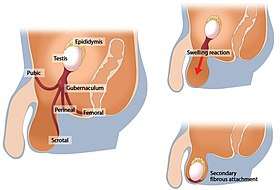Orchiopexy
Orchiopexy (or orchidopexy) is a surgery to move an undescended (cryptorchid) testicle into the scrotum and permanently fix it there. Orchiopexy typically also describes the surgery used to resolve testicular torsion.
| Orchiopexy | |
|---|---|
 Evolution of orchiopexy | |
| ICD-9-CM | 62.5 |
Causes
Undescended testicle
An undescended testicle is unlikely to spontaneously resolve after 6 months and, thus, orchiopexy is usually performed before the age of one year.
The undescended testicle may be located within the normal line of descent (for example, in the inguinal canal) or high in the scrotum or ectopically (i.e. the abdomen). The surgeon may use an endoscope through the umbilicus to locate the testicle, and through other small opening(s) performs the procedure. The higher the testicle, the less successful the procedure. However, the procedure has a high success rate overall.
Retractile testes
This is a kind in which testes are neither fully descended nor purely undescended but testicles are somewhat movable. Means sometimes testes is visible in scrotum and sometimes retract upwards. However this condition is not so dangerous as compared to testes in abdominal cavity but needs surgery/ orchiopexy if testes remain maximum time in abdomen and less in scrotum.
Testicular torsion
Orchiopexy can also be performed to resolve a testicular torsion. If caught early enough and the blood supply can be restored to the testicle, this operation can be performed to prevent further occurrence of torsion. If the blood supply has been interrupted for too long, an orchiectomy must be performed. Sometimes orchiopexy is also done preventively in adults in cases in which the patient has the bell-clapper deformity, retractile testicles. or intermittent torsion.